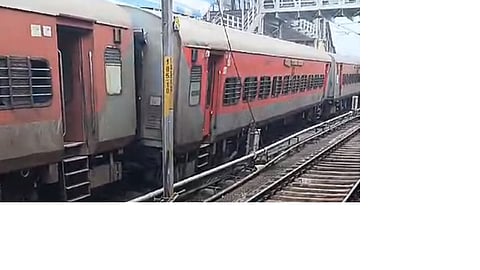

New Delhi | The Commissioner of Railway Safety, in its report on last year's Charminar Express derailment, held delayed braking, non-application of the emergency brake and the shifting of the stop board to the platform dead end, leaving no margin of error, as the causes of the accident.
The train derailed on January 10, 2024, after it hit the dead end at Hyderabad station's terminal platform number five, injuring six passengers.
In its probe report, the Commissioner of Railway Safety (CRS), South Central Circle, said the loco pilot applied the automatic brake late, and the assistant loco pilot failed to apply the emergency brake in violation of safety instructions.
What acted as a trigger to the accident, according to the report, was the station administration shifting the stop board to the dead end, leaving very little or no margin of error for the train crew.
The CRS recommended that both loco pilots and assistant loco pilots should be sensitised to follow safety measures as prescribed under the railway norms.
Following this, the Railway Ministry issued a letter to all zonal railways for the counselling of the running staff.
"The zonal railways have been asked to counsel the running staff to regulate the speed of the train while entering the platform so that they can stop the train before the dead end.
"Besides reminding them to keep the train's speed at 10 kmph when approaching the dead end, they have been advised not to engage in discussion or packing of their belongings at this time," a railway official said.
The CRS also recommended that the stop board at terminal stations be set at an appropriate distance from the dead-end buffer to leave a margin of safety.
In response, the Railway Ministry said that in the General and Subsidiary Rules and Signal Engineering Manual, there is no specific mention of the distance at which stop boards are to be provided from the dead-end buffer stop at the termination station.
The CRS has also advised that passenger lines on terminal platforms should be provided with high-capacity dead-end energy absorption buffer stops. "Policy regarding standard design and installation drawings for dead-end buffers and responsibility for installation and maintenance to be issued by the railways," it said.
Following the CRS recommendation, the Railway Ministry formulated and approved a joint procedure order for the installation and maintenance of dead ends. Besides, it circulated the joint procedure order in all zonal railways, especially in those where buffers needed to be upgraded.
"Further, the Research Designs and Standards Organisation has formulated a schedule of technical requirements for supply, installation and commissioning of high-capacity dead-end energy absorption system for station/Yard for passenger coaches and locomotives in Indian Railways," the ministry has said.
